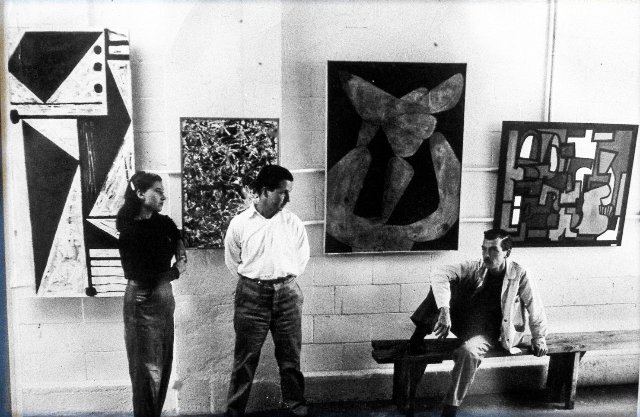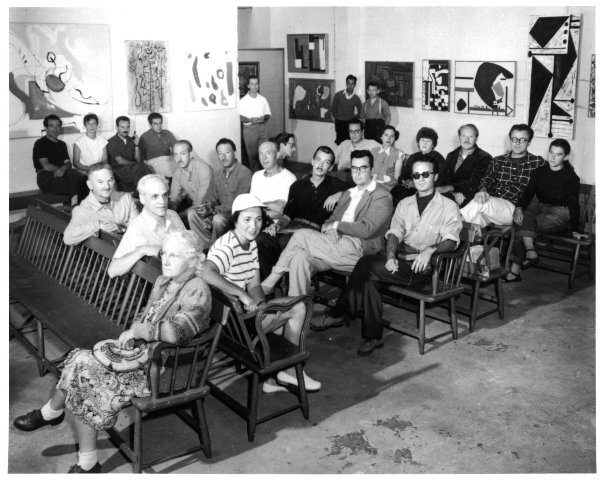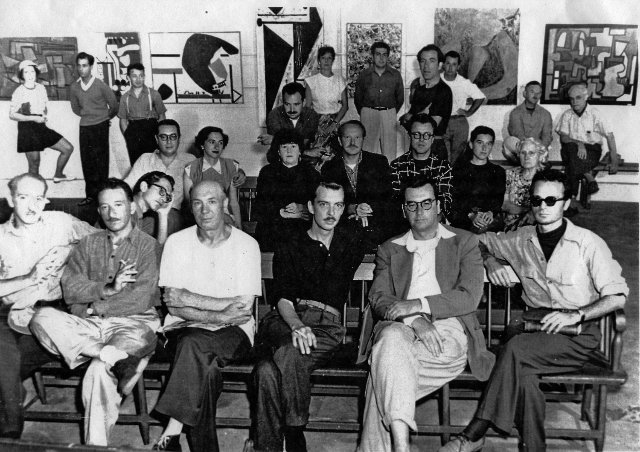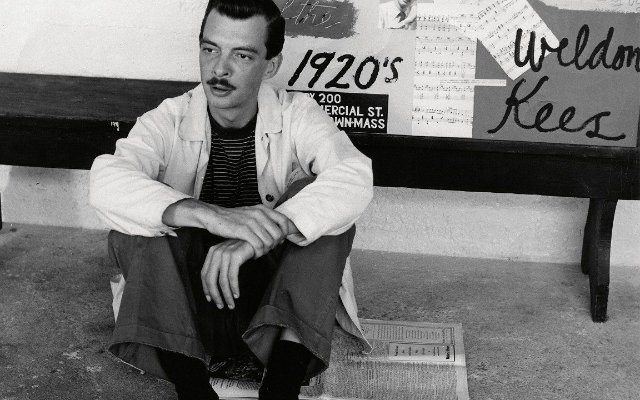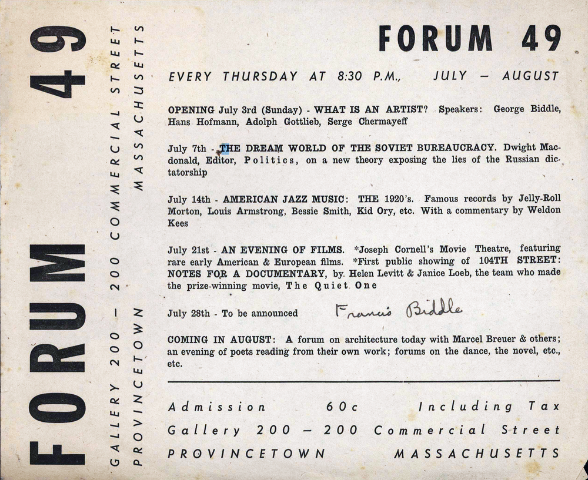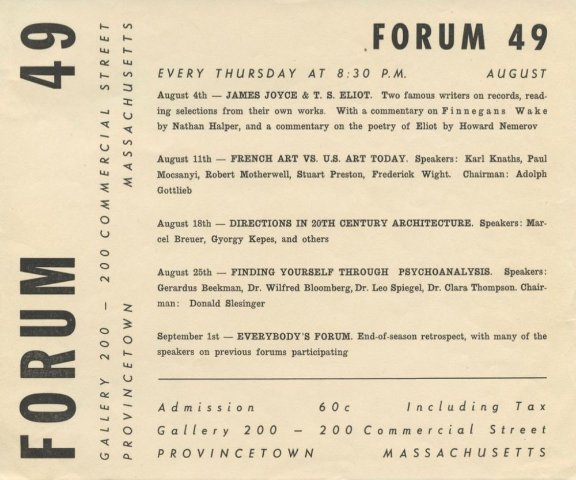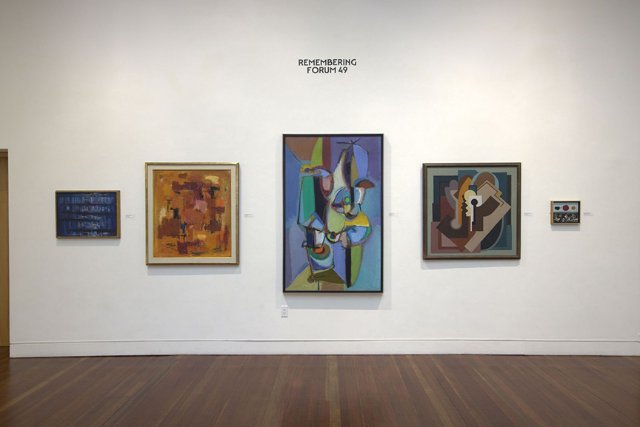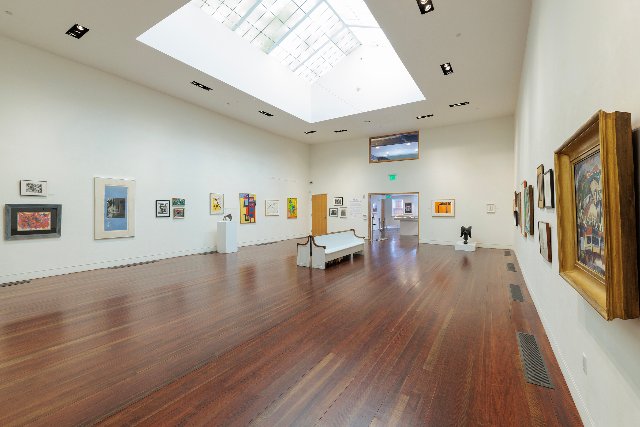Forum '49 in Provinctown Revisited
Summmer Long Exhibitions and Events Spawned the Irascibles
By: Charles Giuliano - Jun 05, 2024
In the aftermath of WWII, Provincetown in the summer of 1949 was the setting for a multi-valent colloquium on epic transition and change in American art and culture. In addition to artists there was dialogue among a critical mass of intellectuals and leaders in a range of fields from psychoanalysis, fine arts, architecture, film, literature and progressive politics.
In that unique and vibrant place and time there was a confluence of individuals who interacted and debated in an independently curated series of exhibitions and events under the umbrella of Forum ’49. It was entirely independent from, and in many aspects opposed to, the perceived conservative policies and reactionary programming of the Provincetown Art Association which was founded in 1914.
On the occasion of its 75th anniversary the Provincetown Art Association and Museum is presenting Remembering 49: Works from the PAAM Collection in conjunction with Forum 24, curated by Grace Hopkins, through June 2, 2024. As much as possible, she has attempted to conjure the spirit of the landmark exhibition. It was staged at Gallery 200 in a former garage on Commercial Street. The original event featured weekly panels and lectures which have inspired the current series of emulating programming.
The Portuguese fishing community on Lower Cape Cod lured artists, writers andradicals through an enticing combination of spectacular waterfront views, brilliant light, and cheap rent. Artists turned shacks into studios or built them in the dunes. At low tide one might harvest clams or get fish from the docks for a hearty meal. Then and now artists had summer jobs in restaurants.
The first generation was chronicled in artist Ross Moffett’s slim volume, Art in Narrow Streets: The First Thirty Three Years of the Provincetown Art Association, 1914-1947. The founding artists focused on representation inspired by nature. They later were regarded as conservative by the emerging post war avant-garde which was on the cusp of giving the dominance of School of Paris a good run for the money.
This did not occur without a good fight which was previewed in Provincetown with global repercussions. What was intensely debated that summer found its way back to New York and erupted in 1950 with a protest against the Metropolitan Museum of Art. Forum ’49 spawned the dissent that later went viral.
The headline of a 1950 New York Times article read “18 Painters Boycott Metropolitan; Charge ‘Hostility to Advanced Art.’” In a letter to the museum it was reported that “All the advanced artists of America will join us in our stand.
“The artists who signed the letter were Jimmy Ernst, Adolph Gottlieb, William Baziotes, Barnett Newman, Clyfford Still, Richard Pousette-Dart, Theodore Stamos, Ad Reinhardt, Jackson Pollock, Mark Rothko, Bradley Walker Tomlin, Willem de Kooning, Weldon Kees, and Fritz Butman. The letter was also signed by ten sculptors with the notation that they supported the artists’ stand. The sculptors were Herbert Ferber, David Smith, Ibram Lassaw, Mary Callery, Day Schnabel, Seymour Lipton, Peter Grippe, Theodore Roszak, David Hare and Louise Bourgeois.”
A group photo of the dissenting painters was published in Life Magazine identifying them as The Irascibles. These artists came to be known as the abstract expressionists, action painters, or simply the New York School. They comprised the focus of the Serge Lifar book “How New York Stole the Idea of Modern Art” or chronicled by Irving Sandler in “Triumph of American Art.”
Regarded as benign, as Lifar argues, American abstract art and jazz were marketed as selling American culture during an era of the Cold War, Red Scare and McCarthyism. The Department of State sent Louis Armstrong and Duke Ellington on world tours as cultural ambassadors of American propaganda. While embraced abroad these jazz musicians faced racism at home.
During the war the surrealists, led by Andre Breton, nested in New York under the patronage of Peggy Guggenheim. Aspects of automatism influenced the emerging artists Arshile Gorky, William Baziotes, and Jackson Pollock among others. Concepts of Jungian analysis informed the work of Pollock. These threads found their way to the panels organized in Provincetown.
That summer gallerist Donald F. Witherstine, director of Shore Studios, expanded his operation renting a former garage. With cosmetic changes it was available to the newly formed committee led by poet/ artist/ musician, Weldon Kees, artist Fritz Bultman and Cecil Hemley a poet and translator from Yiddish. They were joined by artists Karl Knaths and Hans Hofmann to jury exhibitions for the space.
The committee stated that “It ought to bring out, if nothing else, the roots of vital abstract work that had its beginnings in Provincetown not long after WWI. The vanguard work of (E. Ambrose) Webster, (Oliver Newbury) Chaffee, (Agnes) Weinerich and (Blanche) Lazzell is part and parcel of the international aesthetic revolt that took its cue from the School of Paris- a revolt not unconnected with that of the poets, playwrights and novelists who made Provincetown famous in the Twenties.” Of these only Lazzell (1878-1956) was then living.
It is difficult to nail down details of the exhibition programming but it appears that they were displayed with two week runs. The Forum ’49 jurors selected the first two shows and for the rest of the slots Witherstine, starting with an extensive group show, exhibited his roster of artists. The weekly Forums brought capacity attendance which no doubt provided exposure and sales for the gallery.
The second juried show was arguably one of the most important in the history of post war American art. In embryo it may be regarded as the first group show for abstract expressionism although it included artists like Knaths and Lazzell who were not.
Not all of the artists were present, there were loans from New York galleries, but the check list of exhibitors is formidable. It included then “emerging” artists; Jackson Pollock, Robert Motherwell, Adolph Gottlieb, Karl Knaths, Judith Rothschild, Fritz Bultman, Weldon Kees, Perle Fine, Kahlil Gibran, William Baziotes, Byron Browne, Richard Pousette-Dart, Peter Busa, Alexander Calder, Bradley Walker Tomlin, Mark Rothko, Lawrence Kupferman and others.
Reporting for the New York Times, on August 21, 1949 Stuart Preston astutely noted that “ (a) happy state of affairs brings about an unusually even balance of quality between the conservative and advanced works on view at the two principal galleries. Inevitably the Provincetown Art Association is a right-wing stronghold while the new ‘Gallery 200’ stresses modern art. But no iron curtain descends between them. Many artists exhibit in both.”
In a July 17, 1947 posting of Provincetown Art Association Notes there is a heading Weekly Forum. It states that “The Tuesday weekly art forum which has been a popular feature of the Associaton for the past several years was resumed Tuesday evening. Lawrence Kupferman, instructor of painting at Massachusetts School of Art…The topic for Tuesday’s forum was ‘The Position of Non-Objective and Abstract Painting Today…’ “
So the notion of Forum was not unique. But scheduling weekly talks and panel discussions was innovative. In creating the programming organizers Weldon Kees and Fritz Bultman drew on the local community. The series of energizing and ground breaking evenings were locally sourced. It speaks to the diversity and depth of the intellectual and artistic community.
The hot topics of the transitional Post War era were aired. What follows is the complete schedule of events. The zeitgeist was radical and leftist. In that sense the Kees evening of 1920s jazz was retro and conservative. In 1949 Bop was emerging and he appears to have had little interest in this avant-garde development.
Forum 49 Panels
Every Thursday at 8:30 P.M.
Admission 60 cents including tax
Gallery 200, 200 Commercial Street
July 3 (Sunday opening of the exhibition) What Is an Artist? Speakers George Biddle (1885-1973) ran artists projects for WPA, Hans Hofmann (1880-1966), Adolph Gottlieb (1903-1974), Serge Chermayeff, architect, (1900-1996).
July 7th The Dream World of the Soviet Bureaucracy Dwight Macdonald (1906-1982) Editor Politics on a new theory exploring the lies of the Russian dictatorship.
July 14th American Jazz Music: The 1920s, Weldon Kees (1914-1955) Famous records by Jelly Roll Morton, Louis Armstrong, Bessie Smith, Kid Ory, etc.
July 21st An Evening of Films, Joseph Cornell Movie Theatre, featuring rare American and European Films. First public showing of 104th Street: Notes for a Documentary, by Helen Levitt (1913-2009) and Janice Loeb (1913-1996), the team who made the prize-winning film The Quiet One.
July 28th Francis Biddle (nothing is know about this event)
August 4th James Joyce and T. S. Eliot recordings of their readings with Finnegan’s Wake commentary by Nathan Halper (1908-1983) with Howard Nemerov (1920-1991) on Eliot.
August 11th French Art vs. U.S.A Art Today, speakers: Karl Knaths (1891-1971), Paul Mocsanyi (1900-1993), Stuart Preston, (NYT art critic died at 89 in 2005), Frederick Wight (1902-1986 played a significant role in transforming Los Angeles into a major art center at the University of California, Los Angeles, curated shows fo what was later named the Wight Art Gallery), chaired by Adolph Gottlieb (1903-1974).
August 18th Directions in American Architecture, Marcel Breuer (1902-1981), Gyorgy Kepes (1906-2001 founded Center for Advanced Visual Studies at MIT)
August 25th Finding Yourself Through Psychoanalysis Speakers Geradus Beekman, Dr. Wilfred Bloomberg, Dr. Leo Spiegel, Dr. Clara Thompson, Chairman Donald Slesinge
September 1st Everybody’s Forum, End of season retrospect with many of the speakers on previous forums participating.
During the 1980s I researched in Provinctown including an interview that provides direct insight to Forum ’49 by one who participated in the event. Judith Rothschild and her husband, the author, Anton Myrer, were recruited as volunteers by organizer Weldon Kees. The interview was conducted at her home on Provincetown. This is an excerpt of that dialogue.
Judith Rothschild
August 5, 1984
Judith Rothschild (1921-1993), a brilliant colorist with a keen eye for composition, gained success as a young artist in New York in the 1940s. Following her graduation from Wellesley in 1943, Rothschild studied at the Art Students League with Reginald Marsh, at Stanley William Hayter’s Atelier 17, and in Provincetown with Hans Hofmann and Karl Knaths. Relatively unrecognized in her lifetime a foundation to promote undervalued artists of her generation was created. The asset to create it was her personal collection then valued at $33 million. There were also properties including a Park Avenue complex, sold eventually for $15 million (it housed the trustee and foundation for a number of years) and a country home in Kinderhook, N.Y., which sold for $4.1 million in 2008. She owned works among others by Matisse, ten by Mondrian, and “Muse” by Brancusi. She appointed a friend, Harvey S. Shipley Miller, as sole trustee.
In a 2010 New York Times article with the headline “Foundation Promotes Art as Well as Sole Trustee” it was reported that (he)… “has since donated or sold many of these artworks and used the proceeds to benefit cultural institutions across the country…Another major beneficiary of the foundation’s efforts over the years, though, has been Mr. Miller himself.”
Charles Giuliano We are looking at a group shot from Forum ’49 can you identify the individuals?
Judith Rothchild On the back is the identification of everyone. But let’s not take tape time now. The paintings on the wall, right to left are, mine, the next Weldon Kees, Pollock, one of the first he included in a group show, then two by Karl Knaths. It was a invited show mostly from New York galleries, Charles Egan, Sidney Janis, Samuel Kootz, Betty Parsons and Rose Fried where I showed. Karl, as one of the most important local artists, was included in what was an old garage (200 Commercial Street). It was an anti Art Association project. There was still the effect of terrible battles of the 1930s that Karl would tell us about. He didn’t have much to do with the Art Association and considered it pretty much old hat. It was very antique.
That was the idea that motivated Weldon Kees and Fritz Bultman. The idea was to have a kind of weekly forum of various aspects about not just the arts but the culture of our time. There were important people from various fields; psychoanalysis, architecture, film. There were readings of Joyce and Eliot. There was a panel on painting with Knaths and Hans Hoffmann. Then Weldon hosted an evening of jazz. He was the driving force behind it. He kept it all together with tremendous energy, sweetness and enthusiasm.
CG He designed the poster and Reggie Cabral owns the original.
JR Do you have the photo of him seated in front of the poster?
CG He is included as a formative member of the abstract expressionists.
JR I wouldn’t say he was formative. I would say that he was absolutely secondary, not at all central. But he was accepted and showed with them, and was a part of the group. But he was far from being seminal or an influence on other people. Visually, I don’t think he was. He was a force because of a very wide range of knowledge, tremendous enthusiasm, and a sense of the importance of the arts and communication of the arts. He had the ability to get people, in this situation, to get people to participate.
For the last Forum, at the end of the summer (September), I don’t think anyone else will tell you about this, at the very end of the summer we had an extra week somehow. Some people had defected (gone home from vacation) and we didn’t know what to do. So we decided to call it “Everybody’s Forum.” And anybody who wanted to could speak for three minutes. To make sure it was lively we invited some people to speak. I remember Elaine de Kooning was down at the end of the summer. Weldon asked her if she wanted to speak on the role of women artists. I had never met her and didn’t know her at all. I had met him (Willem) but didn’t know her. She stood up and was very nervous. She had written a paper. Her hands were shaking and she sounded like a little school girl. She said this kind of history of women in art. It is incredible now to recall her being so shy and diffident and sort of nervous about presenting that subject.
I don’t know if Weldon chose the subject or she did. If you know her it would be fun to ask her about it. I don’t remember the whole thing. It was kind of a free for all.
CG Forum ’49 had nothing to do with the Art Association?
JR Absolutely not. 200 Commercial Street was a garage in the center of town. They painted it all white. It was so popular we sold tickets. (sixty cents) Ester Gottlieb and I were at the gate. We had to ask a guy to help because people were forcing their way in because we were sold out.
For the speakers we offered a bottle of liquor of their choice as our thanks. They did it for nothing. Afterwards we would have a party and go out to drink somewhere. It was incredible.
CG How did you come to participate in Forum ’49?
JR We had been in California and came East. When we arrived we were new to everything. Nobody knew us. Nobody knew my husband (best selling author, Anton Myrer). So we didn’t get into Forum ’49 until it had been settled. Weldon asked me to participate. There was a lot of physical work to do. My husband also participated. There was a lot of crating to handle, carting things around, and managing guests. There was a lot of arranging to do.
CG Do you recall who was in the show? Was Lawrence Kupferman involved?
JR Yes, he and his wife Ruth Cobb. Lawrence Campbell was sitting next to me. Hoffmann was in it. Pollock was in the show but not in Provincetown at the time. Franz Kline was not in the show but came later. Some of the work we got from NY dealers. Adolph Gottlieb was active in Forum ’49. His wife Ester and I worked a lot together. He had an uncle or cousin or something who had a house on the West End and may have given some money to help it out.
We invited Paul Mocsanyi who runs the art program at the New School for Social Research.
CG He wrote on Karl Knaths.
JR The very same. There was a battle during the course of the summer, which I wasn’t a party to and only learned of it through Weldon. It was the question of the position of advanced American vs. European art.
CG Was that the theme of Forum ’49?
JR No, but that’s what they had a great argument about. Fritz (Bultman) and (Hans) Hoffman had an argument about that. Fritz pulled out around the beginning of August.
(They issued the following statement.)
Protest Against Ostrich Politics in the Arts
The estate of the arts should never be narrowed to a national basis-particularly by the artists.
The greatness of Paris is to offer an invitation of participation to the spirit. If the United States has assumed, as in the past few years, the same free and open attitude, this warrants great promise in the arts. Paris’s humanism has given the opportunity for free development of the artists as the Spaniards- Picasso, Gris, Miro; the Swiss- Klee, Corbusier, Giacometti; the Russians- Kandinsky, Chagall; the Rumanian- Brancusi; the Irishman- Joyce; the Americans, Stein, Man Ray, Carles; the Pole-Lipschitz; and many others.
Still today many of them are living masters of Paris. We earnestly hope that the artistic creation in America will develop the same fruitful ground to equal such a great example.
Hans Hoffmann, Fritz Bultman
CG What was the purpose of Forum ’49?
JR At that time there was a great sense of real excitement in many of these fields. Everything seemed to be opening up.
CG I understand that Norman Mailer and Robert Motherwell came that summer.
JR I didn’t hear Mailer but Bob gave a very good talk. I had met him in New York. After the talk Weldon and Robert came back to our place in the West End, an old net mending shack opposite the Hoffmanns. We had drinks together. Bob was likely in East Hampton. He probably rushed back. Probably gave the talk and rushed back. They came to our place for drinks but not for hours and hours. I suppose he had a plane to catch.
CG Kees appears to have committed suicide in San Francisco. (His abandoned car was found next to Golden Gate Bridge. A body was never recovered.) Did he strike you as a depressed person?
JR No. I’ve talked a lot to both men who are working on his biography. Weldon, I think, was a person with an enormous love of life and appetite for life which you could see when he played jazz. He made up incredibly funny songs. He was a very good jazz pianist. He composed, like when driving in the country, he made up funny, ridiculous songs. “Newton had a trauma/ Got it from his mama/ a woman who distorted many lives/ and the family water closet/ she used to deposit objects/ like cleavers and knives…”
Then we wrote a wonderful song when he was living in Point Richmond. That was when Ford Motors was expanding. There was a little town Mill Pete which had been a nothing town until Ford took it over. He wrote a sweet little ditty based on “Manhattan.” All I remember is “No town is sweet/ as that Old Mill Pete is.” He has a great sense of fun.
CG People say he killed himself. Was he depressed?
JR The measure of his despair was the height and intensity of his hopes. I don’t think he was at all depressed. The human condition being what it is, and he being as sensitive as he was, he was increasingly despairing at what was happening in the arts.
CG He was very handsome.
JR Like Zachary Scott. People were attracted to him. I never thought of him as sexy and I don’t think people did. Not that anyone thought he was homosexual, but you felt warmth, electricity and involvement. When we met I was newly married and not into that kind of thing. But I don’t think that was his quality. He was not a macho guy. He was gentle and his movements were gentle. He was small.
CG What was he painting?
JR They tended to be abstracted biomorphic forms, in ‘49 to’50 on dark backgrounds, usually with quite a bit of texture involved; sometimes using a lot of palette knife.
CG Do you own one?
JR No. Fritz bought one recently and I saw a slide of it. I don’t think it was great but it’s not fair to judge from a slide. Then he was in California. Jim Reidel who is working on a biography has been trying to collect some. (“Vanished Act: The Life and Art of Weldon Kees,” 2003.) He has four or five. There are some in the University of Nebraska. What I liked best of Weldon’s were a large group of collages that he did in the early 1950s for the Palace of the Legion of Honor. They were luminous, wonderful, mostly yellow and white. They were not at all unhappy and full of sunlight. Charming. A little like the early Motherwell collages which were shown at Peggy Guggenheim’s. Probably, actually, a lot like that. He was probably influenced a lot by Bob’s early work.
CG Was Pollock around in 1949?
JR He had left. He had been here, I think, in ’45 or ’46. There is uncertainty about that. Franz Kline bought the same property. Pollock rented it, and then the next summer I rented it, or the summer after. By the time I was in the West Kline bought the whole property and built his studio there.
CG Was Kline around for Forum ’49?
JR No, Kline came after that. I never knew him because he wasn’t here. Barnett Newman was here, I know because I’m a good friend of his wife.
CG Was he in Forum ’49?
JR I don’t think so.
CG What about Edwin Dickinson?
JR I don’t imagine he was. I those days he was rather aloof. He was not a part of this kind of mood. I think that Nat Halper showed him at HCE Gallery. Milton Avery was’t here that summer.
CG But Knaths was.
JR What everyone thought in those days was that there were two important artists in town; Karl Knaths and Hans Hofmann.
CG Not Dickenson. He was often linked with Knaths and Ross Moffett.
JR Dickson was in Wellfleet not Provincetown. Hopper was also here but I don’t recall much talk about him. That’s my opinion and other people may think differently. We tended to think that Hopper was a part of the past. Even though Knaths was somewhat figurative there was a lot of feeling in town of a polarity between Hofmann and Knaths. They were competitors and had to be kept apart. They did not dislike each other and both were very shy, really. They were not adverse to seeing each other. It was a curious thing.
(For the New York Times in 1949 Stuart Preston wrote, “…milling through the crowds on Commercial Street, sensing the indefinable atmosphere of a port town. Purposeful energy abounds. What is on at the Playhouse? Where is the Forum on American jazz of the twenties? Isn’t that Hans Hoffman talking to Karl Knaths and Adolph Gottlieb?”
You have these two men who were both German, they spoke with German accents and both were hard of hearing.
(Knaths was born Otto Karl Knaths, October 21, 1891, in Eau Claire, Wisconsin.)
It reminds me of what Pierre Matisse told me about arranging for Miro and Matisse to meet in Paris. He tells it charmingly. It was a big deal to get these artists together. They met in a café that was decided upon and introductions were made. They ordered drinks. They discussed the weather and events going on in Paris. They finished the drinks then politely shook hands and left. Miro was overjoyed and delighted to have met Matisse whom he greatly admired. That was it and a bit like when Hans and Karl were together. While always polite I don’t think they had much of a conversation.
What follows is information provided by Provincetown Art Association and Museum.
In a dialogue with curator Grace Hopkins she explained to me that “My main take on the event was to talk about the reason we are all out here on Cape Cod. Why do we all flock to this tiny spit of sandbar jutting out into the ocean? Why have we all been coming for decades? Some say it is the light. I believe it is the rarity of a highly intellectual body of people in a small area. Last summer I had to choose where I wanted to spend an evening between an event with Rachel Maddow or hearing Nina Totenberg present from her newest book. Forum 49 was formed because people wanted to discuss the large topics of the day in an informal setting. It garnered the interest of the New York Times because of the high level of participants and thoughts even if it was hundreds of miles from the city itself. We want to celebrate the idea by shining a light on the cultural institutions of the outer cape and banding together to showcase Provincetown’s enduring relevance in the world’s stage.”
Remembering Forum 49: Works from the PAAM Collection
Provincetown Art Association and Museum (PAAM) presents the exhibition Remembering Forum 49: Works from the PAAM Collection, curated by artist Grace Hopkins. On view April 19 – June 2, this exhibition is in conjunction with the Provincetown Art Gallery Association’s Forum 24: The 75th Anniversary of Forum 49.
ABOUT THE EXHIBITION
This exhibition will include works from PAAM’s permanent collection by artists who were featured in the original Forum 49, such as Adolf Gottlieb, Alexander Calder, and Morris Davidson, as well as many works created by artists in Provincetown in 1949.
Forum 49 was a summer-long series of sophisticated programs held in 1949, beginning with the forum “What Is An Artist?” and ending with the controversial “French Art vs American Art Today.” Record crowds attended the exhibits of paintings and programs focused on the avant-garde in many areas (architecture, psychoanalysis, poetry, jazz) all held in a gallery at 200 Commercial Street.
Forum 24 celebrates the 75th anniversary of the seminal Forum 49 presentation of emerging modern art – an event that changed the history of art in Provincetown and worldwide. The Provincetown Art Gallery Association will mark the occasion with a summer of events designed to honor the original Forum and illuminate the connections between modern art and the cultural changes and artistic changes that still resonate in the world today.
ASSOCIATED PAAM EVENTS
Wednesday, July 17, 6pm: “Surrealist Film Shorts: Beginnings.” A screening and discussion with Howard Karren.
Inspired by the surrealist and Dada movements in visual art, Luís Buñuel teamed up with his friend Salvador Dalí to produce this anti-clerical, deliberate assault on bourgeois values, “Un Chien Andalou” (An Andalusian Dog), which changed the face (and figure) of film forever. Maya Deren’s “Meshes of the Afternoon” attempted to give dream imagery a voice and create a genuine independent cinema in the U.S. These two shorts are iconic examples of the birth of surrealist cinema.
The films:
- Un Chien Andalou (1929), “An Andalusian Dog,” directed by Luís Buñuel, written by Buñuel and Salvador Dalí, B&W, 16 min.
- Meshes of the Afternoon (1943), directed by and starring Maya Deren and Alexander Hammid, written by Deren, B&W, 14 min.
Wednesday, July 31, 6pm: “What is an artist?” Panel discussion led by Mike Carroll.
A nod to the program opener for Forum 49 was a discussion “What is an artist?” lead by George Biddle, Hans Hofmann, Adolph Gottlieb, and Serge Chermayeff.
Wednesday, August 21, 6pm: Surrealist Film Shorts: Beyond. A screening and discussion with Howard Karren.
Surrealist imagery soon entered the realm of mainstream filmmaking, appearing mostly as dreams and sometimes full features. Avant-garde artists began to move beyond. Here are two examples: in “Le Chant du Styrène” (“The Song of Styrene”), French New Wave master Alain Resnais turns plastic into poetry, and in “The Order,” a 31-minute excerpt of his three-hour epic Cremaster 3 (part of the nine-hour-long, five-part Cremaster Cycle), Barney looked to create form beyond biology, “cremaster” being the muscle that raises or lowers the testicles in response to temperature.
The films:
- Le Chant du Styrène (1958), “The Song of Styrene,” directed by Alain Resnais, written by Raymond Queneau, color, 13 min.
- Cremaster 3: The Order (2002), written, directed and starring Matthew Barney, color, 31 min.
ABOUT THE CURATOR
Grace Hopkins is a Wellfleet artist, parent, and educator. She is also the steward of the estates of artist Budd Hopkins and art historian April Kingsley: her parents. She earned a BFA in photography from the School of the Fine Arts at Tufts University and has guided the art world for two decades with positions in museums, academics, and galleries. Her innovative photography has been exhibited widely on the Cape and elsewhere. She is the director of the Berta Walker Gallery in Provincetown and a member of the steering committee for the Provincetown Art Gallery Association.
ARTWORK LIST (2024)
Jules Aarons (1921-2008)
Untitled (Sun Gallery interior, painting of face), c. 1949-50
Silver gelatin photograph
Gift of David Murphy, 2008
Untitled (Sun Gallery interior, boy at opening), c. 1949-50
Silver gelatin photograph
Gift of David Murphy, 2008
Portrait of Artist Lawrence Kupferman, c. 1949-50
Silver gelatin photograph
Gift of David Murphy, 2008
Untitled (Sun Gallery, Thompson, Grooms, Milder, figure in doorway), c. 1949-50
Silver gelatin photograph
Gift of David Murphy, 2008
Kahlil (Gibran, playing music on bed), c. 1949-50
Silver gelatin photograph
Gift of David Murphy, 2008
Fritz Bultman (1919-1985)
The Wave, 1977
Bronze
Gift of David Murphy, 2011
Kiting, 1977
Collage of painted papers and gouache
Gift of Renate Ponsold, 2006
Peter Busa (1914-1985)
Untitled, 1940
Oil on canvas
Gift of Emile Arnold, 1967
Alexander Calder (1898-1976)
La Scie et Les Boules, c. 1965
Aquatint on paper, #66/90
Collection of the Cape Cod Museum of Art, Gift of David and Nancy Kaplan
Ellie Award, 1974
Metal
Courtesy of the Estate of Paul Brodeur
Oliver Chaffee (1881-1944)
Sailboats (Christmas card to Blanche Lazzell), 1933
Watercolor on paper
Gift of Helen and Napi Van Dereck, 2007
Nassos Daphnis (1914-2010)
S-12-60, 1960
Acrylic on wood, mounted on oil on wood
Gift of Nat Halper, 1979
Helen Daphnis-Avlon (1932-2004)
Sea Forms, c. 1950
Oil on canvas
Gift of the artist, 1978
Morris Davidson (1898-1979)
Orange Structure, n.d.
Oil on canvas
Gift of Lawrence Richmond, 1975
Nanno de Groot (1913-1963)
Pastorale, 1949
Monotype print
Gift of Pat de Groot, 1982
William Freed (1902-1984)
Untitled (House), n.d.
Watercolor on paper
Gift of Lillian Orlowsky
Martin Friedman (1896-1980)
Untitled (Abstract Landscape), n.d.
Oil on canvas
Gift of Dr. and Mrs. Evelyn Metz, 1982
Kahlil Gibran (1922-2008)
Fledgling, 1950
Oil on panel
Gift of David Murphy, 2019
Adolph Gottlieb (1903-1974)
Imaginary Landscape, 1955
Oil on canvas
Gift from the Richmond Bequest, 1978
John Grillo (1917-2014)
Night Forms, 1946-47
Oil on canvas
Gift of Kathy Grillo, 2011
Hans Hofmann (1880-1966)
Spring, 1946
Oil on board
Norman and Dorothy E. Cook Collection, Gift of Dorothy E. Cook, 2000
William Holst (1912-1995)
Fruit, 1967
Lithograph
Gift of Andrew Young, 2019
Karl Knaths (1891-1971)
Pumpkin, 1964
Oil on canvas
Gift of Mr & Mrs. David Orr in memory of Louise Ault, 1995
Lawrence Kupferman (1909-1982)
Untitled, 1949
Gouache on paper
Gift of Mervin Jules, 1984
Blanche Lazzell (1878-1956)
Painting #12, 1929
Oil on canvas
Gift of Mrs. Robert Sellers, 1956
Leo Manso (1914-1993)
Nightweirs, 1953
Oil on canvas
Gift of Varujan Boghosian, 1983
George McNeil (1908-1995)
Venus, 1957
Oil on board
Gift of Evelyn Metz, 1984
Robert Motherwell (1915-1991)
La Casa de la Mancha, 1984
Etching with aquatint, #10/70
Gift of Harvey S. Shipley Miller and The Judith Rothschild Foundation
Black Douglas Stone, n.d.
Color lithograph
Gift of Marjorie Allegretti
Jan Muller (1922-1958)
Untitled, c. 1950
Oil on wood
Gift of Mrs. Walter McGraw, 1979
Lillian Orlowsky (1914-2004)
Untitled, c. 1955
Oil on canvas
Gift of Frances & Samuel May, 1994
Judith Rothschild (1922-1993)
Untitled, 1988
Two-color lithograph
Gift of Long Point Gallery, 1998
Jack Tworkov (1900-1982)
Untitled, 1950
Ink on paper
Gift of Dr. Stephen Bernstein, 2005
Agnes Weinrich (1873-1946)
The New Road, n.d.
Oil on canvas
Gift of Robert Duffy, 2022
Sol Wilson (1894-1974)
Festival, c. 1950
Lithograph
Gift of Robert Eaton, 2018

